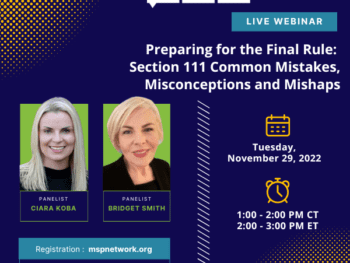
It may seem impossible to move claims that have been on the books for months or years. But the expense to the payer and the inability of the injured worker to move on with his life are not in the best interests of anyone. Instead, stakeholders can reach settlements on these claims by partnering with the right experts and following best practices.
Understanding the Barriers
Empathizing with the injured worker is one of, if not the most important elements to settling claims. Claims managers, faced with a plethora of cases day in and day out, may lose sight of what’s actually going on in the mind of the employee. What they and other stakeholders need to understand is the driving force that keeps some injured workers in the system long-term; fear.
- Fear of running out of money
- Fear of having to navigate the healthcare system alone
- Fear of having no support, from a claims adjuster, nurse case manager, attorney and anyone else who’s been involved with the claim
While in the system, the worker’s medical bills are automatically paid, they have a steady stream of money through indemnity payments, and they don’t have to haggle with providers over money. Once they leave the system, that all goes away. Stakeholders can have much more success settling claims by looking at the situation from the injured worker’s point of view.
Settling long-term claims is complex, as there are many moving parts. An adjuster trying to settle a claim on their own could be overwhelmed, as they would need an in-depth understanding of these and many other issues. That’s why a team approach is imperative to reach more settlements with injured workers.
Click Link to Access Free PDF Download
“8 ‘Think Outside the Box’ Tactics to Settle Workers’ Comp Claims”
The Team
The circumstances of the claim and the injured worker will help determine who should be included on the settlement team. The team should consist of:
- Claims Adjuster. The claims adjuster is the backbone of the claims handling team who leverages the expertise of various settlement team members to both ease their workload and settle claims more effectively.
- Employer. The employer owns the relationship with the injured worker and is an integral part of maintaining communication, rapport, and a connection to the workplace. The working employer-employee relationship will also provide insight into the desires, hopes, and dreams of the injured worker to help create a win-win settlement plan.
- Settlement advisor. Structured settlements can offer significant benefits over lump sums. They are tax-free, periodic payments that are placed with a highly-rated life insurance company. Research has shown that recipients of lump sums often go through the money much faster than expected. Structured settlements help ensure there will be money throughout the person’s lifetime, and even beyond. These also offer flexibility in terms of how they are paid and how much.
- MSA vendor. The Medicare Secondary Payer Act requires that Medicare not pay for coverage that should be the responsibility of a primary payer, which includes workers’ compensation. In addition to workers who already receive Medicare benefits, other workers may also need an MSA. The government has established certain thresholds that determine whether a person who is not currently on Medicare may qualify within a certain timeframe.
The MSA vendor can help
-
- Determine if an MSA is necessary
- Develop the MSA in a way that it can be effectively used for settlement
- Seek approval from the Centers for Medicare and Medicaid Services
- Professional administrator. Professional administration is a post-settlement support system for the injured worker. It fills the void left by the disappearance of all other stakeholders once the case has settled. Professional administrators can help manage the funds, ensure compliance with MSA requirements, and may offer network discounts for medical providers, treatments and medications.
- A defense attorney who has been involved in the claim can be a valuable part of the team, as this person may be able to provide information and documentation, and communicate with the injured worker.
- Medical advisor. In addition to determining whether prescribed medications and treatments are appropriate for the injured worker’s condition, this person can also ensure that any diagnoses are correct. They may also be able to identify brand-name medications that could instead be generics, and determine if prescribed opioids are necessary and, if so, for how long.
4-Step Process
Once the team is established, it can begin the process of getting to settlements with injured workers. Four best practices have been shown to be highly effective.
-
Identify claims for settlement early.
Determine the trigger points of claims that are ripe for settlement. Among them are those in which the injured worker is:
- Physically stable and has consistent medical treatments and prescriptions. An injured worker with upcoming surgery would not be a good candidate for settlement, as the costs may be extremely variable.
- Extremely frustrated, with denials for treatment and/or independent medical exams
- Fearful about running out of money, losing his support system, and dealing with Medicare and the MSA reporting requirements
-
Engage the team.
Typically, the settlement advisor is the point person to move things forward. This person can reach out to the other team members to gain their input on whether the injured worker is appropriate for settlement talks. The advisor can provide and/or obtain information from vendors and other team members such as:
- Medical history
- Attorney representation
- Prescription drug cost projections from Professional Administrator
- Clinical/pharmacy review of the treatment plan
- Pre-MSA triage talks from MSA Vendor
-
Conduct roundtable discussions with the team to leverage settlement best practices.
Building trusted relationships and working together can help the team brainstorm on the various issues involved and determine how best to approach the injured worker, either directly or through his attorney. This stage involves soft tactics as well as technical tactics.
Soft tactics include discussing the worker’s fears, concerns and desires. Technical tactics include such things as gathering documents and information for settlement projections or a MSA, and pricing out future medical treatment and prescription costs. These conversations should also include a look at the post-settlement life of the injured worker and ongoing support, especially through a professional administrator.
-
Negotiate the lowest reasonable settlement amount.
Once the team has discussed a plan, as well as a settlement amount, conversations with the injured worker can begin. The discussions should include all the options and fees involved, such as the approximate $1,000 fee for a professional administrator.
The discussions leading up to the negotiations should be such that all are in agreement that the plan will adequately provide for the injured worker’s life, and is realistic to the payer. Therefore, emotion can be removed from the case.
Summary
Injured workers who are unnecessarily still in the workers’ compensation system will agree to settlements if they can see that the amount of money and ongoing support are appropriate. Gaining an understanding of the injured worker’s thinking and working with the right experts can help payers move claims to settlement.

Contact: mstack@reduceyourworkerscomp.com.
Workers’ Comp Roundup Blog: https://blog.reduceyourworkerscomp.com/
©2019 Amaxx LLC. All rights reserved under International Copyright Law.
Do not use this information without independent verification. All state laws vary. You should consult with your insurance broker, attorney, or qualified professional.














